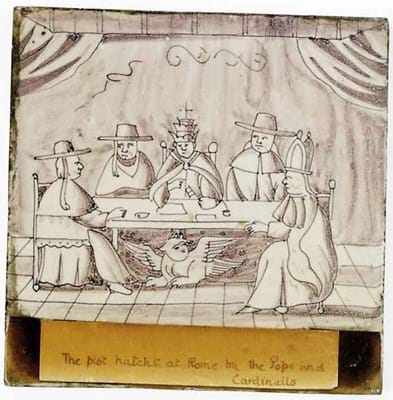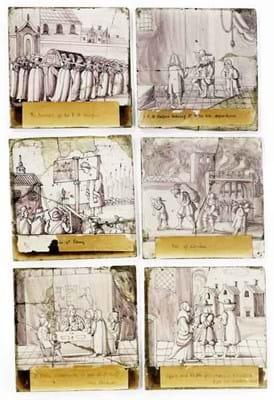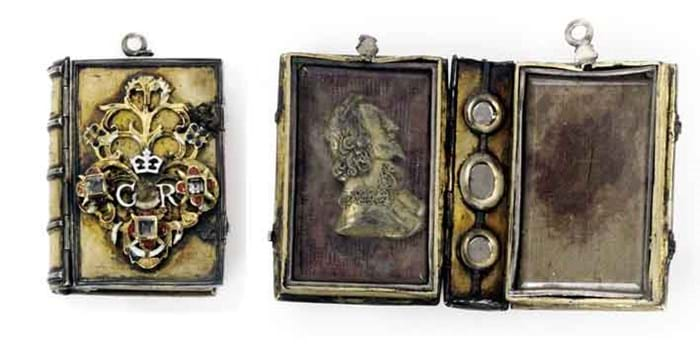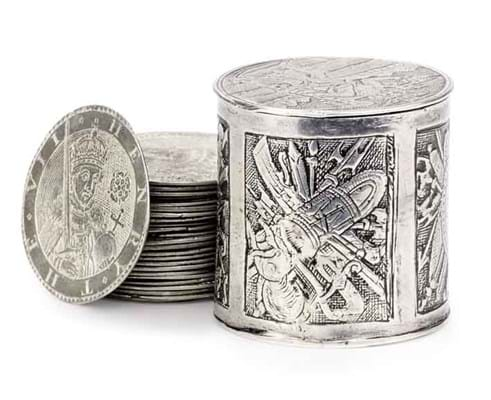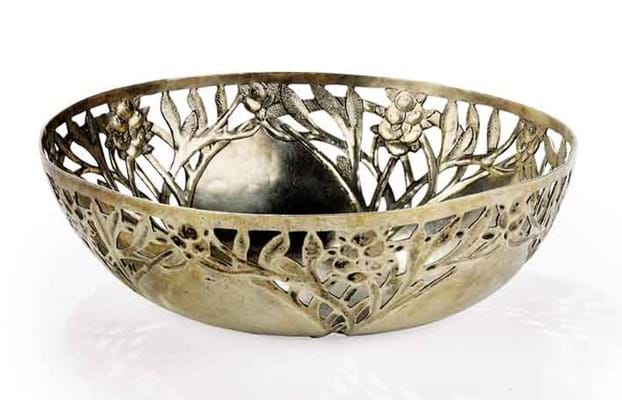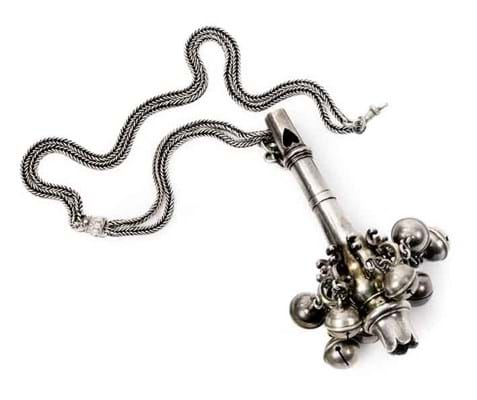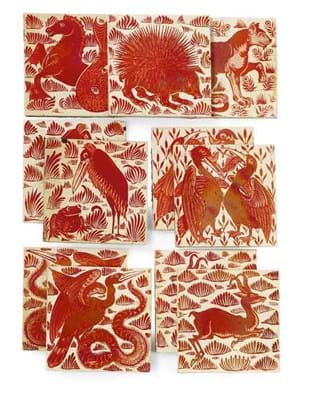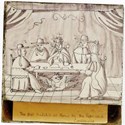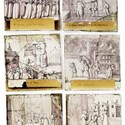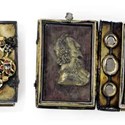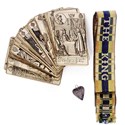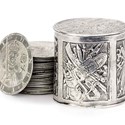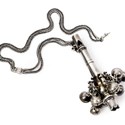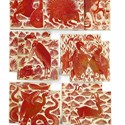This informed his collecting tastes which were for vernacular furniture; early 17th century English embroideries; 17th and 18th century British portraiture in the form of full scale and miniature painting; and Stuart era silver small work and vertu, much of it acquired in the 1960s and 70s through frequenting the London salerooms.
His collection ranged from the general - 17th century joint stools and stumpwork pictures - to the particular - portraits of Charles II and Nell Gwynne or late 16th century Popish Plot tiles and Royalist mementoes.
The collection may not have been a multi-million consignment but it had the ingredients to make the specialist enthusiast salivate.
It was market fresh and had a themed coherence. Add some largely conservative estimates and small wonder it was a virtual sell-out with just three of the 113 lots left unsold and plenty of prices that outstripped estimates by decent rather than perplexing levels.
Popish Plot Tiles
A set of ten manganese Popish Plot tin-glazed tiles of c.1680-1700, all of which were purchased at Sotheby's in 1971, were offered here as five lots and realised a total of £10,300.
The Popish Plot, a fabricated conspiracy put about by Titus Oates and the Protestant Dr Tonge that Charles II was to be overthrown and Protestants massacred, ended in the execution of 14 Jesuits and ultimately Oates' arrest and conviction for perjury.
The affair c.1678-81, was promulgated widely through a set of engravings which formed the source for the narrative scenes on playing cards and tiles.
Here at CSK, six of the tiles were offered together and sold at £3000 (est: £2500-4000) while the single tiles ranged in price from £1600 up to £2400 for The plot hacht at Rome by the Pope and Cardinals, estimated at £700-1000.
Stuart Souvenirs
Dr Gordon's enthusiasm for the Stuart era extended to period souvenirs and one of these, a Charles I reliquary shaped as a tiny book, led the day on £8500.
The quintessential souvenir for a Stuart enthusiast, this tiny 2in (5cm) high silver gilt-metal and enamelled bookform pendant was gemset and enamelled to the front with his initials, a crown and a fleur de lys and contained a cut-out portrait of the King and a piece of blood-stained cloth.
It has a provenance to Major Cyril Sloane Stanley, a descendant of Sir Hans Sloane from whom it may have been inherited. One the day, it was also sold to Alastair Dickenson for £8500.
The Jermyn Street dealer told ATG he would have been prepared to go to three times that level to secure it. He reckoned it was a particularly good example of Stuart memorabilia and while it was missing its clasp, it was in highly original, unspoilt condition.
Also at the sale was a Royalist souvenir jewel and a Charles I silver locket containing a Royal portrait which were offered together with a long 18th century Royalist revival sash and a well preserved 17th century pack of Popish Plot playing cards. The group easily outstripped its humble £600-800 estimate to take £4000.
The most expensive entries amongst Dr Gordon's small collection of 17th century portraits were, predictably enough, the oval half-length study of Nell Gwyn by a follower of Sir Peter Lely which realised £5200 and, at £4400, a portrait of Charles II ascribed to a follower of John Michael Wright.
This showed the monarch wearing the Order of the Golden Fleece and had a provenance, according to an inscription on the reverse, to George Harnage (1767-1836)1st Baronet of Belleswardine, Shropshire.
Along with a handful of items that had direct associations with the Stuart monarchy the sale also featured period pieces: 17th century embroideries, oak furniture, and portrait miniatures. Most of these sold along predicted lines although the oak performed a little below par.
Silver
The keenest competition came with the silver.
While silver is hardly the most bullish market, the smallwork and collector's pieces that Dr Gordon favoured in the 1970s is still popular and this was a particularly nice group. Amongst the most keenly contested pieces was an early 18th century eightbell rattle struck only with a Britannia Standard mark for John Hugh Le Sage, c.1720 and lotted with a routine 1920s Birmingham rattle. This lacked the coral teether, but was of exceptional gauge with a solid cast handle and by a well regarded maker.
It was purchased by London dealer Alastair Dickenson who pronounced it "the finest 18th century rattle I've ever seen", going to £3000 to secure it.
A small 3.75in (9cm) wide unmarked oval mirror with a hinged cover pierced with silver gilt flowers and foliage dated to the second half of the 17th century was taken to £2400 and a 2oz Commonwealth period wine taster of c.1650 with an unascribed maker's mark to the rim fetched £2000.
Demand extended to the best of the later collector's pieces. An almost miniature, 2in (5cm) high, pair of silver travelling candlesticks that screw together to form a circular box, marked for Joseph Guest London, 1812 was a case in point at £2700 as was a 9in (23cm) long ear trumpet marked for Thomas Phipps and Edward Robinson London, 1808 which sold with a Sheffield plate example of c.1800 for £4500.
Some of the most popular elements in the collection were English Arts and Crafts era 'signed and designed' pieces. The silver included the 8in (20cm) diameter silver bowl by Charles Robert Ashbee of characteristic openwork and spot hammered style pictured here that realised £4200 and 11 William De Morgan 6in (15cm) square tiles decorated on Craven Dunhill blanks in ruby lustre with a menagerie of different animals.
Purchased as a single lot at Christie's in 1978 they were offered here as three pairs and one trio with all pursued to double estimate or more as detailed in our illustration.

